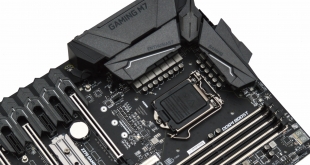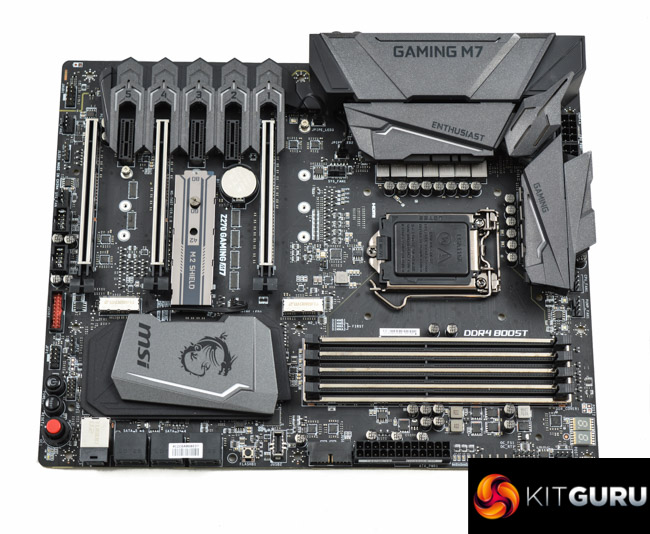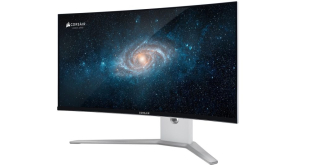
MSI's Gaming motherboard range, signified by the MSI Dragon, has proven very popular since it was first introduced . MSI's recent lineup has consisted of an M3, M5 and M7, with the M7 being the top of the Gaming series – second in MSI's Z270 portfolio only to XPower. Today we put MSI's Z270 Gaming M7 on test to see what MSI's high-end gaming motherboard has to offer.

MSI's Gaming M7 has has typically been overshadowed by the Gaming M5. Arguably, the MSI Gaming M5 motherboard has delivered a more optimal balance of features and pricing for consumers. In the past MSI has struggled to do enough to set the M7 apart from its more affordable sibling. Indeed it appears the differences between the M5 and M7 will be a pertinent consideration for prospective buyers of MSI's new Gaming Z270 motherboards.
Priced at around £240 | $240 | €280 the MSI Gaming M7 leans towards the upper-end of the Intel Z270 motherboard market. Motherboards in direct competition include the ASUS ROG Maximus IX Hero, EVGA Z270 FTW K, Gigabyte AORUS Z270X-Gaming 7 and ASRock Fatal1ty Z270 Gaming i7, all of which sit in that £220-280 price bracket for premium motherboards. The MSI Z270 Gaming M5 retails for around £190 | $200 | €240 making the M5 a considerably more affordable option than the M7.
What the M7 includes that the M5 doesn't is an extra M.2 port, front USB 3.1 Type-C header, an additional Realtek ALC1220 codec, OC features (slow mode, OC retry, etc.), power/reset buttons, enhanced memory compatibility and a more powerful CPU VRM with an additional supplementary power connection. Whether those differences combined offer enough utility and value to push consumers to make that extra spend, remains to be seen and will ultimately depend on the person.
It seems that with Intel's Z270 chipset and Kaby Lake platform being so generously equipped as standard motherboard vendors are having a tougher time creating higher-end motherboard SKUs where premiums can be justifiably charged. In the past the difference between a mid-range motherboard could have meant sacrificing access to cutting-edge connectivity standards or simply having less available in the way of networking, storage and USB connectivity.
With the Z270 generation and the last couple of Intel Z-Series chipset generations the differences have been more subtle including minor variations that have a sizeable impact on development and production costs for motherboard vendors, and subsequently the retail price, but little impact on the real-world end-user experience.
| MSI Z270 Gaming M7 | |
| Form Factor | ATX, 30.5 cm x 24.4 cm |
| CPU Socket | LGA 1151, 11 Phase (8+2+1) VRM |
| Chipset | Intel Z270 |
| Memory | DDR4, 4 DIMMs, up to 64GB, up to 4133MHZ+ with OC, 2 Phase VRM |
| Onboard Graphics | Intel HD Graphics (supported CPUs), up to 1024MB of video memory |
| Discrete Graphics | Up to Nvidia 2-way/Quad SLI, AMD 3-way/Quad CrossFireX |
| Expansion Slots | 3 x PCIe 3.0 x16 (x16/x0 or x8/x8 or x8/x4/x4 from CPU) 3 x PCIe 3.0 x1 (from PCH) |
| Storage | 6 x SATA III* (All from PCH) 3 x M.2* 1 x U.2* *M2_3, U2_1 and SATA5+6 share the same bandwidth. Maximum of six SATA HDDs and 2 M.2 PCIe SSDs at a time. |
| USB | 3 x USB 3.1 (2 Rear (1 Type-A and C),1 Front (Type-C) all from ASM2142) 6 x USB 3.0 (2 Rear, 4 Front, all via PCH) 7 x USB 2.0 (3 Rear, 4 Front, all via PCH) |
| Networking | 1 x Killer E2500 Gigabit LAN |
| Audio | 2 x Realtek ALC1220 Codecs 7.1 Channel HD Audio |
| Fan Headers | 6 x 4-pin fan headers (1 x CPU, 1 x W_PUMP, 4 x SYS) |
| Rear I/O | 1 x PS/2 mouse & keyboard combo port 3 x USB 2.0 Type-A ports 1 x Clear CMOS button 1 x DisplayPort 1 x HDMI port 1 x LAN (RJ45) port 2 x USB 3.1 Gen1 Type-A ports 1 x USB 3.1 Gen2 Type-A port 1 x USB 3.1 Gen2 Type-C port 1 x Optical S/PDIF OUT connector 5 x OFC audio jacks |
| UEFI | 1 x 128Mb flash, UEFI AMI BIOS |
 KitGuru KitGuru.net – Tech News | Hardware News | Hardware Reviews | IOS | Mobile | Gaming | Graphics Cards
KitGuru KitGuru.net – Tech News | Hardware News | Hardware Reviews | IOS | Mobile | Gaming | Graphics Cards



The first motherboard to have two audio codecs? We take a look at MSI’s intriguing Z270 Gaming M7
Bah you got me, that was verging on clickbait ; ) I was expecting a separate page filled with amazing audio info but I had to hunt through for titbits and I’m still non the wiser.
My theory is all of the single codec Z170 motherboards are only Amplified to one of the channels, in my case with the Maximus Gene to the front panel, this motherboard appears to be amplified to the front and rear channels, maybe for speakers/headphones or headphones/headphones i’m thinking VR without having to reach around and swap headsets all the time. Just a thought.
I have this motherboard and it is absolutely awesome. The double audio codecs is great, but I use a soundblaster card anyway which is still better. I am just very much impressed overall with this board, its looks, and it features. It feels like a solid high quality product. Sure the M.2 Thermal Shield is a gimmick, but shouldn’t really be considered a negative. I just took it off and used that slot for a Samsung 950 Pro. With good case air flow you won’t have any throttling issues anyway. I never have.
Apologies, not my intention! Yes the only amplified channel is usually the headphone out port (green when colour codec) since only headsets usually need the amplification (or significantly benefit from it). This is indeed amplified for the front and back headset ports since the ALC1220 codec has built in amplifiers meaning there are two on this, one per codec.
No apologies needed I was just joking. Yeah that was my theory, maybe they are crazy enough to think people want two sets of headphones at once. Like the person playing VR and the person watching on a monitor or maybe for the gamer with a short headphone cable and VR who doesn’t want to swap his headset back to front all the time. I’m really clutching at straws here.